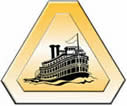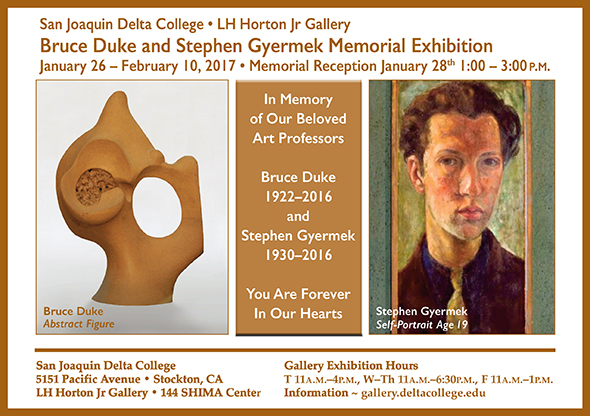
 San Joaquin Delta College 5151 Pacific Ave., Stockton CA 95207 |
Media Advisory For More Information Contact: Jan Marlese L.H. Horton Gallery Director (209) 954-5507 jmarlese@deltacollege.edu http://gallery.deltacollege.edu |
For Immediate Release
01/19/2017
L.H. Horton Gallery Presents
Bruce Duke and Stephen Gyermek Memorial Exhibition

(Stockton, CA) Delta Center for the Arts L.H. Horton Jr. Gallery is honored to present the work of former Art Professors Bruce Duke and Stephen Gyermek, January 26 - February 10, 2017. A Memorial Reception to celebrate the lives and work of these two great artists and arts educators is planned for family and friends on Saturday, January 28 from 1 - 3 p.m.
San Joaquin Delta College faculty and staff are saddened by the loss of two of our founding art professors, Bruce Duke and Stephen Gyermek, who both passed away in October 2016. We are grateful to their daughters, Cathy Anderson, Jodi Duke, and Katrinka Gyermek, for working with the Gallery staff to loan works for the exhibition. On display are several large ceramic sculptures by Bruce Duke, including a ceramic portrait of Stephen Gyermek, as well as a portrait of the artist with his long-time colleague, Jim Lewis, who is also retired Delta College Art Professor. In addition, several of Stephen Gyermek’s paintings and woodblock prints (including the original woodblocks) line the walls of the Gallery. Bruce and Stephen were both accomplished artists and inspiring educators who will be missed by all who knew them.
About the Artists…
Bruce Duke received his Masters Degree in sculpture, working under Erwin Frey at Ohio State University in 1947. However, Herbert Sanders’ influence in ceramics at San Jose State University during his undergraduate studies was so strong that his creative efforts after graduation turned to ceramics. Initially, and for several years, his creative work was motivated by a study of plant forms. At that time most of his ceramics were pots, but had the feeling of nature. Slowly his forms took a more sculptural attitude, influenced by the abstract expressionist movement of the 1960s.
In 1976 he visited Bernard Leach and Barbara Hepworth’s studios in St. Ives, England. Bruce stated that, “Seeing many of Hepworth’s sculptures and the rock formations in St. Ives that inspired her, I was moved emotionally. I began to reassess my own work while at the same time studying pebbles and rocks I collected. This is a pure simple elemental form that suggests a timelessness that I saw in no other form. For several years my work was influenced by these rocks.”
During the late 1980s Bruce’s work took a new creative direction, as he explored the possibilities of melding together the human figure and the architectural column in a Greek manner. Ancient Greek art was particularly interesting to Bruce, not only for its classic beauty, but also because of its “sensitive expression and fantastic skill.” Being Greek may have also explained why he had such a strong feeling for Greek culture and architecture, which was a strong source of inspiration in his ceramic work.
Exploring various sculptural forms, Bruce used the high fire reduction method and slab construction. Bruce stated that, “While the potter’s wheel has its purpose, I’ve always felt that it limits my creativity and have always been drawn to hand-built ceramics.” Bruce taught ceramics at Delta College from 1948 to 1987. He once stated that his “greatest passion was in teaching the art of ceramics.” Many of his ceramic students went on to become distinguished ceramic artists, including Bill Albright, Viola Frey, Michael Lucero, and Joe Mariscal (who was hired to teach ceramics upon Bruce’s retirement, and is now retired as well). When Bruce retired from Delta College he continued his creative work in ceramics, including building a working kiln in his backyard. He was an active member of the San Joaquin Potters Guild.
Born in 1930 Budapest, Hungary, Stephen Agoston Gyermek comes from a long lineage of artists. His great grandfather, Janos Gyermek, born in 1847, was a glass and porcelain painter. His father, Dr. Laszlo Gyermek II (1898-1960), completed his medical degree in Budapest, during which time and onward, he painted, did photography and sang in choirs throughout his life. In the autumn of 1944 his father was enlisted as a medic for the Hungarian army front. In 1945 he was captured by the Russians, and spent the next four years in a Gulag (the government agency that administered Soviet penal labor camp systems), eventually ending up in a German war camp.
In 1948 Stephen fled Hungary to live in Holland, just months after the return of his father, due to the communist religious persecution. Stephen was accepted to the Fine Arts Academy in Amsterdam (Rijkakademie voor Beeldende Knutsen) in 1949, where he studied painting, painted glass, mosaics, and woodblock prints. His teacher was Heinrich Camperdonk (1889-1957), an artist who escaped from Hitler to Holland, and who was a member of the German Expressionist groups Die Brücke (The Bridge - founded in 1905) and Der Blaue Reiter (The Blue Rider - founded 1911-1914). The influence of German Expressionism is dramatically seen in the style and design of Stephen’s exquisite woodblock prints. Portraiture, figurative works, still-life settings and religious subjects are the primary themes in his artwork.
In October 1953 Stephen received a scholarship to the Madrid Academy of Fine Arts in Spain, where he studied the restoration of the Academia San Fernandon panel mural, as well as art history, his main focus of study. He considers his mosaic at the Sagrada Familia de Urgel College as his most important work while living in Spain.
Immigrating to the United States in 1957 with his wife, Elise, he first lived in Oklahoma where he taught art history, religious art and drawing at Saint Gregory’s College. While there, he oversaw the establishment of the college art museum. He also designed 12 windows for Saint Gregory’s Abbey, including the glass window facade of Saint Joseph in Adba, and a mosaic of the Vatican. Stephen and Elise moved to Stockton in 1965, where he worked as the Director of the Haggin Museum until 1970. In 1966, he began teaching evening courses in art history at Delta College, and by 1970 he was a tenured faculty member. He taught introductory courses in art history, as well as Asian, pre-Columbus American and Spanish art history. He retired from Delta College in 1998, and continued to live and work as an artist in Stockton.
###